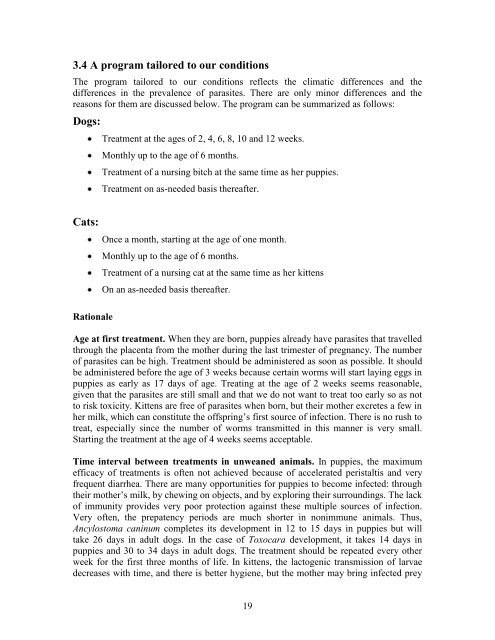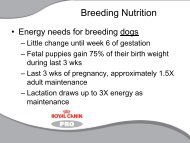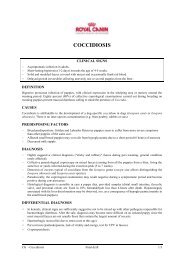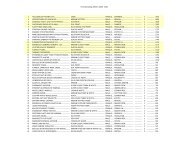Guide to Preventing Parasites.pdf - Royal Canin Canada
Guide to Preventing Parasites.pdf - Royal Canin Canada
Guide to Preventing Parasites.pdf - Royal Canin Canada
Create successful ePaper yourself
Turn your PDF publications into a flip-book with our unique Google optimized e-Paper software.
3.4 A program tailored <strong>to</strong> our conditions<br />
The program tailored <strong>to</strong> our conditions reflects the climatic differences and the<br />
differences in the prevalence of parasites. There are only minor differences and the<br />
reasons for them are discussed below. The program can be summarized as follows:<br />
Dogs:<br />
Cats:<br />
Rationale<br />
Treatment at the ages of 2, 4, 6, 8, 10 and 12 weeks.<br />
Monthly up <strong>to</strong> the age of 6 months.<br />
Treatment of a nursing bitch at the same time as her puppies.<br />
Treatment on as-needed basis thereafter.<br />
Once a month, starting at the age of one month.<br />
Monthly up <strong>to</strong> the age of 6 months.<br />
Treatment of a nursing cat at the same time as her kittens<br />
On an as-needed basis thereafter.<br />
Age at first treatment. When they are born, puppies already have parasites that travelled<br />
through the placenta from the mother during the last trimester of pregnancy. The number<br />
of parasites can be high. Treatment should be administered as soon as possible. It should<br />
be administered before the age of 3 weeks because certain worms will start laying eggs in<br />
puppies as early as 17 days of age. Treating at the age of 2 weeks seems reasonable,<br />
given that the parasites are still small and that we do not want <strong>to</strong> treat <strong>to</strong>o early so as not<br />
<strong>to</strong> risk <strong>to</strong>xicity. Kittens are free of parasites when born, but their mother excretes a few in<br />
her milk, which can constitute the offspring’s first source of infection. There is no rush <strong>to</strong><br />
treat, especially since the number of worms transmitted in this manner is very small.<br />
Starting the treatment at the age of 4 weeks seems acceptable.<br />
Time interval between treatments in unweaned animals. In puppies, the maximum<br />
efficacy of treatments is often not achieved because of accelerated peristaltis and very<br />
frequent diarrhea. There are many opportunities for puppies <strong>to</strong> become infected: through<br />
their mother’s milk, by chewing on objects, and by exploring their surroundings. The lack<br />
of immunity provides very poor protection against these multiple sources of infection.<br />
Very often, the prepatency periods are much shorter in nonimmune animals. Thus,<br />
Ancylos<strong>to</strong>ma caninum completes its development in 12 <strong>to</strong> 15 days in puppies but will<br />
take 26 days in adult dogs. In the case of Toxocara development, it takes 14 days in<br />
puppies and 30 <strong>to</strong> 34 days in adult dogs. The treatment should be repeated every other<br />
week for the first three months of life. In kittens, the lac<strong>to</strong>genic transmission of larvae<br />
decreases with time, and there is better hygiene, but the mother may bring infected prey<br />
19







